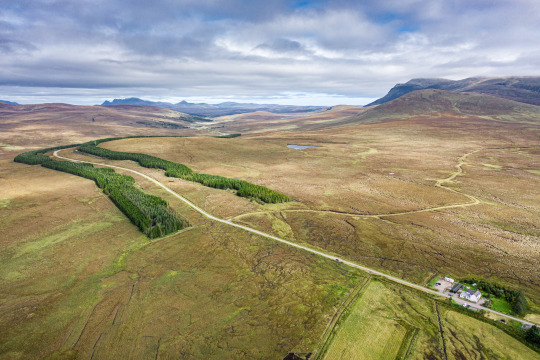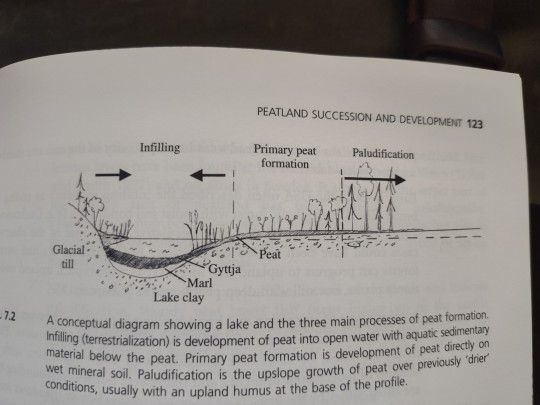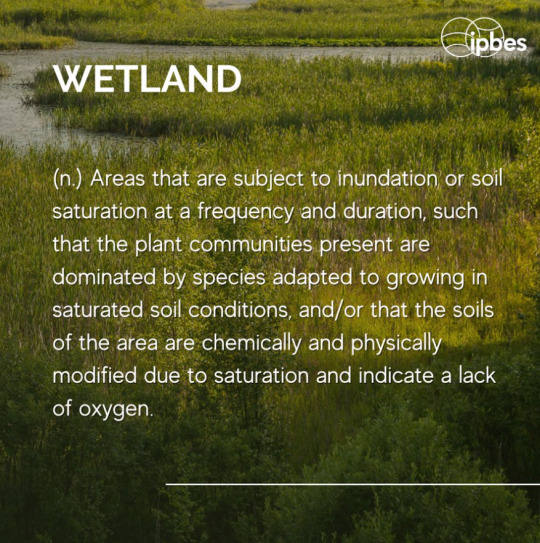#peatlands
Text

Peatland area per country
The biology of Peatlands , John jeglum. ISBN: 0198528728
2 notes
·
View notes
Link
Excerpt from this story from the New York Times:
The Democratic Republic of Congo, home to one of the largest old-growth rainforests on earth, is auctioning off vast amounts of land in a push to become “the new destination for oil investments,” part of a global shift as the world retreats on fighting climate change in a scramble for fossil fuels.
The oil and gas blocks, which will be auctioned in late July, extend into Virunga National Park, the world’s most important gorilla sanctuary, as well as tropical peatlands that store vast amounts of carbon, keeping it out of the atmosphere and from contributing to global warming.
“If oil exploitation takes place in these areas, we must expect a global climate catastrophe, and we will all just have to watch helplessly,” said Irene Wabiwa, who oversees the Congo Basin forest campaign for Greenpeace in Kinshasa.
Congo’s about-face in allowing new oil drilling in environmentally sensitive areas comes eight months after its president, Félix Tshisekedi, stood alongside world leaders at the global climate summit in Glasgow and endorsed a 10-year agreement to protect its rainforest, part of the vast Congo Basin, which is second in size only to the Amazon.
The deal included international pledges of $500 million for Congo, one of the world’s poorest nations, over the first five years.
But since then, the world’s immediate priorities have shifted.
Russia’s invasion of Ukraine sent oil prices soaring and led to U.S. and British bans on Russian energy and, last week, a call to ration natural gas in Europe.
At the same time, Norway, a leading advocate of saving forests, is increasing oil production with plans for more offshore drilling. And President Biden, who pledged early in his term to wean the world from fossil fuels, traveled to Saudi Arabia recently where he raised the need for more oil production. Back home, Mr. Biden’s ambitious domestic climate agenda is largely doomed.
Congo has taken note of each of these global events, said Tosi Mpanu Mpanu, the nation’s lead representative on climate issues and an adviser to the minister of hydrocarbons.
Congo’s sole goal for the auction, he said, is to earn enough revenue to help the struggling nation finance programs to reduce poverty and generate badly needed economic growth.
“That’s our priority,” Mr. Mpanu said, in an interview last week. “Our priority is not to save the planet.”
15 notes
·
View notes
Photo

The beauty of bogs: Photographer Luján Agusti grew up in the southern part of Argentina and focused on the peatlands of Tierra del Fuego—South America’s largest—for a project on lowering Earth’s carbon emissions. Bogs and wetlands, she tells us, “retain carbon dioxide in enormous quantities, even more than forests do.” Her images, from this Nat Geo article, show the beauty of what she calls the planet’s connector: “They connect land and water; life and death; the past, the present, and our future.”
PHOTOGRAPH BY LUJÁN AGUSTI, @LUJANAG
#lujan agusti#photographer#@lujanag#national geographic#bogs#peatlands#tierra del fuego#south america#argentina#landscape#nature
19 notes
·
View notes
Text
The government has been accused of reneging on commitments by failing to deliver policies on nature-friendly farming, the use of peat and pesticides, reintroducing beavers and other lost species, and protecting rare marine life.
There are fears that the ambition to enhance England’s biodiversity has been lost after the prime minister’s authority became weakened and he is having to listen to the right wing of the Conservative party, which views green measures as too expensive.
Johnson’s headline ambition in his speech to Conservative conference last year was to “build back beaver”, promising they would soon be released into the English countryside, but the government has still not granted permission for the rodents to be released. Conservationists had expected to be given the green light by early summer this year.
Craig Bennett, the chief executive of the Wildlife Trusts, said “We are still waiting for approval to release beavers. It is one of many examples of laws which we have been promised, but have not come through.”
Other promised bills that have not appeared include a ban on horticultural peat use, which has been consulted on but no legislation has been put forward. This would help halt the destruction of England’s peatlands, which are one of the most significant stores of carbon in the country.
The government also last year promised to form a species reintroduction taskforce, which would look at how to bring back animals that are extinct or almost extinct in England. Despite applications for the chair of the taskforce closing in February there have been no further announcements.
On rewilding, the government has not legislated on the recommendations in the landscapes review, such as amending the statutory purpose to ensure the core function of protected landscapes should be to drive nature recovery.
There have also been fears that the government has rowed back on pesticides after promises for an integrated pest management scheme to be included in the new farming subsidies did not come to fruition. Ministers have also not published, as promised, a national action plan on the sustainable use of pesticides.
Dr. Lissa Batey, the head of marine conservation at the Wildlife Trusts, said: “We’re seeing a perfect storm of threats to nature from every quarter caused by government inaction, delay and reneging on commitments.
“The government can’t keep stalling and jeopardising its targets to halt nature’s decline by 2030, reduce carbon emissions and, ultimately, tackle the biggest threats we face of biodiversity loss and climate change. This is urgent – we live in one of the most nature-depleted countries in the world and we must take action, fast, for all our sakes.”
#boris johnson#farming#rewilding#peatlands#marine life#beavers#carbon capture#environment#biodiversity
10 notes
·
View notes
Text
youtube
Peatlands are real carbon storing champions. But as we need more farmland, we're drying them up at alarming rates and release enormous amounts of CO2 in the process. What to do about it? Well, there might just be a way to do both — keep the ground wet AND grow food on it.
Reporter: Kai Steinecke
Camera: Henning Goll
Video editor: Kai Steinecke
Supervising editors: Joanna Gotschalk, Malte Rohwer-Kahlmann
We're destroying our environment at an alarming rate. But it doesn't need to be this way. Our new channel Planet A explores the shift towards an eco-friendly world — and challenges our ideas about what dealing with climate change means. We look at the big and the small: What we can do and how the system needs to change. Every Friday we'll take a truly global look at how to get us out of this mess.
#PlanetA #Peatlands #SustainableAgriculture
Read more:
History and future of peatland emissions:
https://www.nature.com/articles/s4155...
Restoring peatlands:
https://eprints.ncl.ac.uk/file_store/...
Water level and emissions:
https://www.nature.com/articles/s4158...
Paludiculture in Germany:
https://link.springer.com/article/10....
Chapters:
00:00 Intro
00:34 Welcome to the wet farm
03:37 Carbon storing champs
05:16 Paludiculture
07:50 How to rewet?
09:39 Talking money
11:21 Conclusion
#dw planet a#solarpunk#peatlands#uk#germany#Paludiculture#water#co2#carbon dioxide#climate crisis#carbon sink#carbon storage#climate chaos#climate change#global heating#global warming#farmland#farming#agriculture#Youtube
4 notes
·
View notes
Text
Why the global water crisis needs local solutions?
Water security is under threat as competing socio-economic and environmental priorities make sustainably managing this finite resource difficult. Some suggest applying the global principles of climate change mitigation, but volumetric targets or offsets ignore the regional factors that drive the water crisis. Instead solutions must be local and account for the ecology of individual watersheds and how communities use resources, write Dr Derek Vollmer and Dr Ian Harrison of Conservation International, an IUCN Member organisation.
7 notes
·
View notes
Text
We're watching a documentary on peatlands and i have no idea just how LONG those things are
#peatlands#peat bog#grasses#environmental#no wonder peat is so important#plus they can get so long 8 or even 12 meters dating back to the LAST ICE AGE#keeping carbon in the earth which is vital
6 notes
·
View notes
Text

A drone shot of the blanket bog (a type of peat bog) in the Scottish Highlands. This is from my 2019 project titled “Exporting Is Great?” which investigated the UK Export Finance department and how the UK government is helping to fund fossil fuel installations in foreign countries. Check the full project here.
Whilst peatlands only cover 3% of the worlds land area they hold Nearly 30% of all the carbon stored on land. The Flow Country which is an area in the north of Scotland stores about 400 million tonne's of carbon, more than double the amount in all of Britain's woodlands. Due to rising temperatures this habitat is at real risk from climate change, as the bog dries it releases its stored carbon, only fueling the issue.
UKEF has been under pressure to stop aiding in the financing of fossil fuel installations, thankfully there has been some progress in recent months.
#uk export finance#ukef#climate change#fossil fuels#global warming#climate emergency#climate crisis#scotland#blanket bog#peatlands
3 notes
·
View notes
Text

A diagram showing the 3 main processes of peat formation
The biology of Peatlands , John jeglum. ISBN: 0198528728
1 note
·
View note
Text
Watch "Painting for the Katingan Peatlands 🦧" on YouTube
Please consider donating if you are able. Peatlands are an incredibly important part of our global ecosystem. They trap carbon and house many endangered species. Donating $5 or more will get you a digital copy of the featured painting. Through vangoghandloveyourself on YouTube.
#art#environment#donations#important#conservation#peatlands#carbon#endangered#endangered animals#painting#beautiful#ecosystem
0 notes
Link
Excerpt from this story from the New York Times:
For centuries, the Irish have used peat from bogs to fuel the home fires. Stories of families coming together to bring home “the turf,” as peat is called in Ireland, evoke idyllic memories of a poorer, but simpler, life on the land. But now the Irish government, in the name of fighting climate change, conserving habitat and improving air quality, is moving to restrict the use of peat — and finding that it is not easy.
Ireland has more than half the European Union’s remaining area of a type of peatland known as raised bog, one of the world’s rarest habitats and, scientists say, the most effective land form on earth for sequestering carbon.
“The bogs are our Amazon rainforest. They are where most of our carbon is stored,” said Éanna Ní Lamhna, a botanist and author.
Yet despite domestic and European laws that now ban the cutting of turf on many bogs, Ireland has so far proven unable, or unwilling, to stop people who insist on exercising what they see as their traditional right to cut turf.
Last week, the European Commission warned Ireland that it must do more to protect peatlands, citing a discussion about regulations that began more than a decade ago. In a report, the commission said that Irish citizens were openly defying the laws that restrict cutting on protected bogs, and that even those laws were too lax and failed to meet European goals.
5 notes
·
View notes
Link

#geoengineering#chemtrailing#enhanced weathering#earth#nature#sky#weather manipulation#weather#environment#chemicals#soil#toxins#peatlands#trees#plants#forests#flora and fauna#air#climate#sun#atmosphere#balance
0 notes
Text
keberhasilan restorasi gambut?
tingginya pendapatan rumah tangga, tidak serta merta rumah tangga tersebut tidak akan merambah gambut. jika usahanya tersebut berbasis lahan, bukan tidak mungkin terdapat potensi perluasan usaha tersebut ke arah gambut.
jika masyarakat mendapatkan manfaat ekonomi dari gambut, masyarakat tersebut tentu akan menjaga kondisi gambut tersebut. bagaimana jika masyarakat memanfaatkan gambut dengan mengeringkannya, sehingga gambut perlahan hilang?
tingginya pendidikan seseorang, tidak serta merta membuat seseorang sadar untuk tidak merusak gambut. kesadaran seseorang terhadap manfaat gambut bukan bergantung pada tingkat pendidikan.
lalu, bagaimana menjamin agar gambut tetap basah sehingga fungsinya terjaga?
masyarakat biasa bergerak atas keperluan ekonominya, terutama jika wilayah tersebut secara umum ekonominya rendah - tapi sebetulnya, apa inti dari pemenuhan kebutuhan ekonomi? sandang, pangan, dan papan terjaga. tapi seringkali, jika ketiga tersebut pun sudah terpenuhi - banyak rumah warga yang tinggal di ekosistem gambut jauh lebih luas dibanding rumah-rumah orang kantoran di pusat-pusat kota, seseorang tersebut tidak merasa cukup. tagihan listrik? telpon? biaya kesehatan? biaya pendidikan? kadang juga pemenuhan lifestyle -- misal hape yang tidak mau ketinggalan jaman, atau kredit elektronik yang barangkali sebenarnya tidak terlalu diperlukan.
pada akhirnya sepertinya, indikator keberhasilan gambut, tidak hanya bisa dilihat dari tinggi rendahnya ekonomi seseorang, tapi kesadaran mereka juga untuk tidak merusak gambut, atau bagaimana memanfaatkan gambut tanpa merusaknya. pengetahuan itu harus ada di warga yang tinggal di ekosistem gambut.
gimana?
0 notes
Text
Do the goths know about the grotesque imagery of the bog??? Do they know about sphagnum moss and the non-crustose lichens? the moss, blood red, evoking flesh, evoking the soft yeldingness of the inside of your cheek... the lichen, brittle, evoking bones, evoking the delicate vessels of the lungs? Do the goths know that these things grow together? Do they know that sometimes the lichen grows on the red moss, like a crown of bone on a pillow of blood? In a land where little lives and nothing rots? Do the goths know about the bog????
#i know tumblr girlies love a bog body#but there are many other rich veins of imagery in your local peatland!#many untapped!#me fein
542 notes
·
View notes
Text
Unlocking the enigmatic language of biodiversity.

Peatlands, Marshes, Swamps,Sloughs, Fens, Bogs, Wet Meadows... are some of the names often used to describe #wetlands But what is a wetland according to IPBES.
#Peatlands#Marshes#Swamps#Sloughs#Fens#Bogs#Wet Meadows#wetlands#wetlandrestoration#wetlands and human well being#IPBES#ForNature#biodiversity#fres
1 note
·
View note